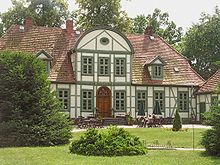Friedrichsmoor hunting lodge
The Friedrichsmoor hunting lodge is located in the district of the same name in Neustadt-Glewe in the middle of the Lewitz in western Mecklenburg and was the hunting seat of the Mecklenburg dukes. The sparsely populated "Lewitz" was an ideal hunting area. Today the hunting lodge is surrounded by old oaks. To the north, the Breite Graben flows past the castle and a deciduous forest adjoins the castle grounds.
history
Around 1704, Friedrich Wilhelm I (Mecklenburg) had a log cabin, clad in Swedish style and painted with oak boards, built as a hunting lodge on the site of today's restored hunting lodge. The builder was supposedly the engineer-captain Jacob Reutz, who was also responsible for the development of the Schwerin Schelfstadt and its Schelfkirche . According to an old Havemann chronicle, the hunting lodge was built with beams laid on top of one another. The joints are sealed with moss, the walls are covered with oak boards and painted. The facility consisted of the corps de logis with two floors and two single-storey wings. In the dining room of the Duke had let abconterfeyen all his old hunter life-size, which are made very similar ... . The roof of the corps de logis was covered with wooden shingles. As blacksmith's calculations show, the hunting lodge must have been completed in 1709. Nothing remains of the old hunting lodge.
In 1791, Duke Friedrich Franz I , first Grand Duke of Mecklenburg-Schwerin, had his new half-timbered hunting lodge built on the site of the old hunting lodge in Friedrichsmoor. The single-storey three-wing complex was built by the court architect Johann Christoph Heinrich von Seydewitz by 1793. The center of the courtyard and garden façade was highlighted by a three-axis roof bay window with a semicircular blind gable.
At the time of construction there was a shortage of wood because the Lewitz was almost completely deforested by 1770. The foresters of the forestry office in Friedrichsmoor, which had been in existence since 1709, who had to procure the timber, took care of reforestation over the years.
Until 1918 the building was used exclusively for hunting purposes by the sovereigns. In the 20th century, the deer rut in September was the highlight of the hunt. With the exception of these four to six weeks a year, the building was empty. Before the hunting season, the house was cleaned up once a year and the interior walls were whitewashed with lime. The chief forester was responsible for maintaining the hunting lodge. Well-known visitors included Kaiser Wilhelm I , Wilhelm II and Chancellor Otto von Bismarck .
From 1957 the FDJ youth camp " Meliorationsobjekt Lewitz" was housed here, which had set itself the goal of improving the agricultural management of the area. After that, the Institute for Improvement of the University of Rostock was the legal entity of the castle. Until the fall of the Berlin Wall it remained a school property and office building of the VEB Meliorationsbau. Since 1991 the hunting lodge, interrupted between 1996 and 2000, has been used as a restaurant, café and hotel after extensive renovation in accordance with listed buildings. There are also several hotel rooms in the Marstall, the former horse stable of the Duke.
Once upon a time, four aisles emanated from the castle as radial avenues that can no longer be recognized today. Most of the 15 km long, dead straight connection to the Ludwigslust residential palace has been preserved .
Worth seeing
Since 1964, the scene wallpaper La chasse á Compiègne (The Hunt of Compiegne) has been located in the middle room of the hunting lodge with the flight of stairs to the garden, which was printed in Paris around 1815 by the Jaquemart & Bernard company based on designs by Antoine Charles Horace Vernet . The wallpaper is probably the only surviving copy that was acquired in 1816 by Grand Duke Friedrich Franz I through a Hamburg company. It previously hung in the Friedrichsthal hunting lodge north-west of Schwerin . It depicts five scenes of a courtly deer hunt in the forest. The special feature of the wallpaper are the red hunting skirts from Napoleon's time, which were banned after Napoleon's fall in 1815. After renewed restoration, the hunting wallpaper has been on the walls of the garden hall in Friedrichsmoor again since 2004.
See also
Web links
- Literature about Jagdschloss Friedrichsmoor in the state bibliography MV
- Internet presence of the hunting lodge Friedrichsmoor
- Plan of Friedrichsmoor from 1709
Individual evidence
- ^ Gerhard Steiniger: Master builder in Mecklenburg from eight centuries. Schwerin 1998 ISBN 3-928820-88-5 pp. 65-68.
- ↑ Horst Zänger: The Friedrichsmoor Hunting Lodge. Traditional gem in the countryside. Schweriner Express, April 5, 2014 p. 9.
- ^ Johannes Voss: Restoration of visual art works. In: Monuments in Mecklenburg. 1976 p. 278.
Coordinates: 53 ° 27 ′ 33 ″ N , 11 ° 34 ′ 15 ″ E

